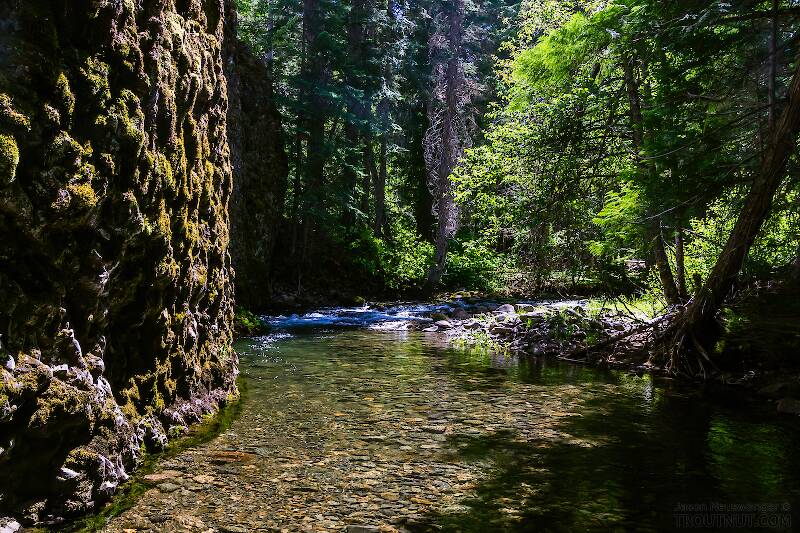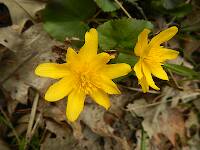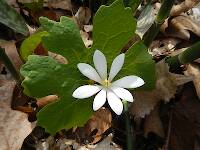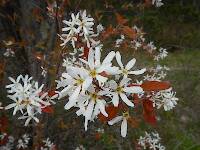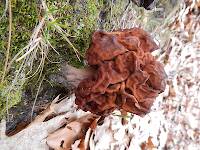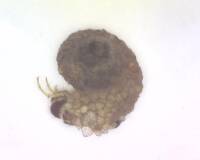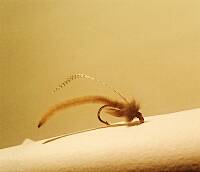
Blue-winged Olives
Baetis
Tiny Baetis mayflies are perhaps the most commonly encountered and imitated by anglers on all American trout streams due to their great abundance, widespread distribution, and trout-friendly emergence habits.
Featured on the forum

Troutnut is a project started in 2003 by salmonid ecologist Jason "Troutnut" Neuswanger to help anglers and
fly tyers unabashedly embrace the entomological side of the sport. Learn more about Troutnut or
support the project for an enhanced experience here.
Dave1352 on Oct 2, 2008October 2nd, 2008, 4:47 am EDT
I am fairly new to fly fishing and i hope to fish as often as possible during the winter.I live in western n,y, and i fish small to medium streams for trout.I have been having some success with dry flies the last couple of months or so,and i was wondering what flies and methods would be the most effective in the winter.This has become such a addiction that i don't think i could stop for a few months.Any suggestions anyone could offer would be greatly appreciated
RleeP on Oct 2, 2008October 2nd, 2008, 9:58 am EDT
Well, welcome to a pastime that is just about the most fun you can have standing up, as they say...:)
Without getting all windy, here's a few things that come to mind that may be of help in Winter fishing on small to medium waters:
1) Trout activity in all seasons is strongly tied to water temps and the 2 seasons of water temp extremes, winter and summer, will be the times when this factor has the most influence. In the Winter, it pays to look for streams that have strong spring input. These will have the highest water temps in Winter just as they will have the lowest temps in Summer. So, if you know of streams in your area that, for example, have a reputation for being the last to freeze (or never freeze) in the coldest winters, these are likely to be your best bets for winter fishing. Stream selection to optimize (in this case, maximize) water temps is also about common sense things like fishing later in the day when the water temps are at their daily peak. While there are exceptions, you're likely to do better from noon to 4PM than from say, 8AM to noon.
2) This next is a theory with no real backing, but I'll put it out there anyway.. In cold water fishing, I've noticed that the magnitude of the rise in water temps often *seems* to precipitate fish activity that is somewhat out of proportion to the actual temperature of the water. Perhaps that is not well put... I've had more than a few times when winter fishing that the trout have turned on pretty vigorously when the water goes from say, 36F to 41F over the course of a few hours. 41F is still pretty damn cold, but the fish hit like the water had gone to 50F or more. It's an odd thing, to say the least. So, the gist of it is that you can expect to be surprised now and then by fish activity that seems all out of proportion to the water temp. In my view, there is something in this dynamic that is more about the amount of the temp. change than the temp. itself. If that makes any sense...:)
3) Finally, in Winter you can expect to find most small stream fish in the deeper pools where they don't have to expend a lot of energy fighting current. For the most part, you don't need to bother with the broken or pocket water. There are exceptions to this, but not many, IMO. A very effective tactic (although not the most exciting fishing you'll ever experience) is to get a wooly bugger down and slowly walk it across the bottom of these deeper pools. Give every pool a thorough working. The fish are sleepy and lethargic this time of year and you may have to put the fly past them more than once to pique their interest. The same can be done with a pair of nymphs (in places where you have enough current to allow them to drift) or a streamer.
For this fishing, I liked all olive, olive/black or all black wooly buggers, mostly in size 10, but 8's and sometimes 12's are good too. Any good streamer will work. I used to like Eric Leiser's Llama, but its kinda obscure. Black marabou streamers or time-tested bucktail patterns like the Black Nose Dace are good too. In small freestones, just about any buggy looking nymph in sizes 12-16 will catch these fish. Hare's Ear, PT, black stone, simple muskrat nymph and Whitlock's Fox Squirrel are some of my favorites.
Not to close this out like a travel brochure, but the Winter is a wonderful time to be on the water. The streams show an entirely different face from the warm seasons and it is a face with a special beauty all its own. And in these days when it seems like there are more guys than even on our favorite streams, you'll never feel so wonderfully alone as what you usually will on winter water.
Even if you don't catch many fish, it's more than worth it, IMO..
And there I went getting all windy anyway...:)
Without getting all windy, here's a few things that come to mind that may be of help in Winter fishing on small to medium waters:
1) Trout activity in all seasons is strongly tied to water temps and the 2 seasons of water temp extremes, winter and summer, will be the times when this factor has the most influence. In the Winter, it pays to look for streams that have strong spring input. These will have the highest water temps in Winter just as they will have the lowest temps in Summer. So, if you know of streams in your area that, for example, have a reputation for being the last to freeze (or never freeze) in the coldest winters, these are likely to be your best bets for winter fishing. Stream selection to optimize (in this case, maximize) water temps is also about common sense things like fishing later in the day when the water temps are at their daily peak. While there are exceptions, you're likely to do better from noon to 4PM than from say, 8AM to noon.
2) This next is a theory with no real backing, but I'll put it out there anyway.. In cold water fishing, I've noticed that the magnitude of the rise in water temps often *seems* to precipitate fish activity that is somewhat out of proportion to the actual temperature of the water. Perhaps that is not well put... I've had more than a few times when winter fishing that the trout have turned on pretty vigorously when the water goes from say, 36F to 41F over the course of a few hours. 41F is still pretty damn cold, but the fish hit like the water had gone to 50F or more. It's an odd thing, to say the least. So, the gist of it is that you can expect to be surprised now and then by fish activity that seems all out of proportion to the water temp. In my view, there is something in this dynamic that is more about the amount of the temp. change than the temp. itself. If that makes any sense...:)
3) Finally, in Winter you can expect to find most small stream fish in the deeper pools where they don't have to expend a lot of energy fighting current. For the most part, you don't need to bother with the broken or pocket water. There are exceptions to this, but not many, IMO. A very effective tactic (although not the most exciting fishing you'll ever experience) is to get a wooly bugger down and slowly walk it across the bottom of these deeper pools. Give every pool a thorough working. The fish are sleepy and lethargic this time of year and you may have to put the fly past them more than once to pique their interest. The same can be done with a pair of nymphs (in places where you have enough current to allow them to drift) or a streamer.
For this fishing, I liked all olive, olive/black or all black wooly buggers, mostly in size 10, but 8's and sometimes 12's are good too. Any good streamer will work. I used to like Eric Leiser's Llama, but its kinda obscure. Black marabou streamers or time-tested bucktail patterns like the Black Nose Dace are good too. In small freestones, just about any buggy looking nymph in sizes 12-16 will catch these fish. Hare's Ear, PT, black stone, simple muskrat nymph and Whitlock's Fox Squirrel are some of my favorites.
Not to close this out like a travel brochure, but the Winter is a wonderful time to be on the water. The streams show an entirely different face from the warm seasons and it is a face with a special beauty all its own. And in these days when it seems like there are more guys than even on our favorite streams, you'll never feel so wonderfully alone as what you usually will on winter water.
Even if you don't catch many fish, it's more than worth it, IMO..
And there I went getting all windy anyway...:)
GONZO on Oct 2, 2008October 2nd, 2008, 10:11 am EDT
And there I went getting all windy anyway...
:) :) As you might expect, Lee, I sympathize completely. Your advice to Dave is excellent!!! Well done.
Dave1352 on Oct 2, 2008October 2nd, 2008, 5:26 pm EDT
Gonzo.Thanks so much for your reply.I feel better already.I have been a spin fisherman all my life but i have always wanted to fly fish.This can be a very humbling pastime.I have been spending a lot of time reading about aquatic insects and fly patterns but i have not seen anything in the books about trout feeding habits in the winter.After almost a year of trial and error i have finely started to catch a few trout on a fairly consistant basis.I am enjoying this to much to wait until spring.Thanks again for your kindness.Dave
GONZO on Oct 2, 2008October 2nd, 2008, 6:05 pm EDT
You're quite welcome, Dave, but my only contribution was to admire Lee's spot-on response to your inquiry. (And to agree with all of it.) I'm sure you meant to address your thanks to him instead of me, but I'll take this opportunity to add my welcome and best wishes to his. :)
Dave1352 on Oct 3, 2008October 3rd, 2008, 5:14 am EDT
You are correct. I intended to thank Lee but once again,My fingers work faster then my brain
RleeP on Oct 3, 2008October 3rd, 2008, 6:12 am EDT
>>You are correct. I intended to thank Lee but once again,My fingers work faster then my brain>>
Not a problem at all, Dave.
I got to be windy. Everything after that is gravy...:)
Not a problem at all, Dave.
I got to be windy. Everything after that is gravy...:)
Leakywaders on Oct 5, 2008October 5th, 2008, 12:17 pm EDT
LEE
I agree with the temp change theory. I've seen it in my own aquarium -wife turned the heat up while dusting, and the fish went hyper, and ate, ate, ate till they burned up. I also noticed that if you watch the bass fishing shows the air temp is ALWAYS higher than the water temp. The one time I saw a show with the water temp higher than the air temp Jimmy Huston went 4 hours withoiut catching a fish. Rick Tayler talks about it in his book SCINTIFIC BASS FISHING. I've never seen a scientific study on it tho.
If I lived in western New York, I would be terrified of winter too. Isn't that where the phrase " Lake effect snow" came from?
Leaky Waders
I agree with the temp change theory. I've seen it in my own aquarium -wife turned the heat up while dusting, and the fish went hyper, and ate, ate, ate till they burned up. I also noticed that if you watch the bass fishing shows the air temp is ALWAYS higher than the water temp. The one time I saw a show with the water temp higher than the air temp Jimmy Huston went 4 hours withoiut catching a fish. Rick Tayler talks about it in his book SCINTIFIC BASS FISHING. I've never seen a scientific study on it tho.
If I lived in western New York, I would be terrified of winter too. Isn't that where the phrase " Lake effect snow" came from?
Leaky Waders
Drag free??? If the fly didn't drag, I wouldn't know where it was!!
Softhackle on Oct 6, 2008October 6th, 2008, 4:30 am EDT
Hi All,
While I do not live exactly in western NY, I live close enough. There can be some very good fishing, here, in winter IF you know where to go. These places are far and few between and can actually get quite busy. Of course we have great steelhead runs, and brown trout spawning, too, but it seems like Dave is looking for something else. There are some streams and rivers that stay open to trout fishing all year long, and they fish quite well if you know how to do it. Rather than name these places openly, I can suggest that Dave get the NY State fishing syllabus and check out these places. There is also information online at the NY State DEC web site.
Good luck Dave, and keep us informed.
Mark
While I do not live exactly in western NY, I live close enough. There can be some very good fishing, here, in winter IF you know where to go. These places are far and few between and can actually get quite busy. Of course we have great steelhead runs, and brown trout spawning, too, but it seems like Dave is looking for something else. There are some streams and rivers that stay open to trout fishing all year long, and they fish quite well if you know how to do it. Rather than name these places openly, I can suggest that Dave get the NY State fishing syllabus and check out these places. There is also information online at the NY State DEC web site.
Good luck Dave, and keep us informed.
Mark
"I have the highest respect for the skilled wet-fly fisherman, as he has mastered an art of very great difficulty." Edward R. Hewitt
Flymphs, Soft-hackles and Spiders: http://www.troutnut.com/libstudio/FS&S/index.html
Flymphs, Soft-hackles and Spiders: http://www.troutnut.com/libstudio/FS&S/index.html
Dave1352 on Oct 6, 2008October 6th, 2008, 3:22 pm EDT
Mark.Thank you for your suggestions,they sound like good ideas.You are correct in that there are some good streams around here that are open all year.Sometimes people think that western n,y,is above the Artic circle but when we are not eating blubber and hunting Walrus,we can fish in the winter. I was fishing the river below Wellsville last month.Do you find any particular flies or techniques good for the colder months.Any information you can share would be appreciated.Thanks again,Dave
Softhackle on Oct 7, 2008October 7th, 2008, 3:33 am EDT
Hi Dave,
My suggestions for flies--HMM. Weighted/beaded nymphs like a Hare's Ear in various sizes have always worked well for me. Try tying some with a touch of olive hare's ear, too. Another good nymph to weight and try is a good old Zug Bug.
Look here: http://www.danica.com/flytier/mlibertone/mels_nautilus.htm
This is one of my favorites.
The Baetis imitations seem to work well in small sizes. As mentioned by RLeeP, water temp does play important part in how trout are feeding. Sometime, you almost need to hit them on the head. Use your thermometer frequently.
Also large attractor patterns such as big weighted wets or streamers fished slowly also work well at times. Another favorite of mine for getting deep is my Fuzz Puppy
http://www.danica.com/flytier/mlibertone/fuzz_puppy.htm
Many times, during winter, I go to a full sinking line to insure I get deep enough to get to the trout's level. I'm sure a good sink tip line would work well, too.
Mark
My suggestions for flies--HMM. Weighted/beaded nymphs like a Hare's Ear in various sizes have always worked well for me. Try tying some with a touch of olive hare's ear, too. Another good nymph to weight and try is a good old Zug Bug.
Look here: http://www.danica.com/flytier/mlibertone/mels_nautilus.htm
This is one of my favorites.
The Baetis imitations seem to work well in small sizes. As mentioned by RLeeP, water temp does play important part in how trout are feeding. Sometime, you almost need to hit them on the head. Use your thermometer frequently.
Also large attractor patterns such as big weighted wets or streamers fished slowly also work well at times. Another favorite of mine for getting deep is my Fuzz Puppy
http://www.danica.com/flytier/mlibertone/fuzz_puppy.htm
Many times, during winter, I go to a full sinking line to insure I get deep enough to get to the trout's level. I'm sure a good sink tip line would work well, too.
Mark
"I have the highest respect for the skilled wet-fly fisherman, as he has mastered an art of very great difficulty." Edward R. Hewitt
Flymphs, Soft-hackles and Spiders: http://www.troutnut.com/libstudio/FS&S/index.html
Flymphs, Soft-hackles and Spiders: http://www.troutnut.com/libstudio/FS&S/index.html
JOHNW on Oct 7, 2008October 7th, 2008, 9:13 am EDT
My winter fly selection tend to lean to the very simple
Walt's worm from size 8 3xl to size 16 depending on water levels
Olive Pheasant tail nymp in #16-18
Pale yellow glow bug #14
Shenks white minnow #8
Shenks white sculpin #8
And Varied simple scuds size 12-18
As you can see the selection is very heavily subsurface oriented. I do carry a small selection of midges and baetis/BWO for those rare days whent the temp picks up enough to put trout on the rise this usually is just some griffiths gnats, spent wing style spinners, and Al's Rats.
Winter is by far my favorite time of year to fish as I frequently have the stream to myself and that is worth the day out. Then again I am blessed to live in a limestone belt with some pretty well known spring creeks to visit.
John
Walt's worm from size 8 3xl to size 16 depending on water levels
Olive Pheasant tail nymp in #16-18
Pale yellow glow bug #14
Shenks white minnow #8
Shenks white sculpin #8
And Varied simple scuds size 12-18
As you can see the selection is very heavily subsurface oriented. I do carry a small selection of midges and baetis/BWO for those rare days whent the temp picks up enough to put trout on the rise this usually is just some griffiths gnats, spent wing style spinners, and Al's Rats.
Winter is by far my favorite time of year to fish as I frequently have the stream to myself and that is worth the day out. Then again I am blessed to live in a limestone belt with some pretty well known spring creeks to visit.
John
"old habits are hard to kill once you have gray in your beard" -Old Red Barn
Quick Reply
Related Discussions
Topic
Replies
Last Reply
1
Sep 14, 2010
by SlateDrake9
by SlateDrake9
5
May 22, 2017
by Jmd123
by Jmd123
1
Mar 29, 2009
by Taxon
by Taxon

